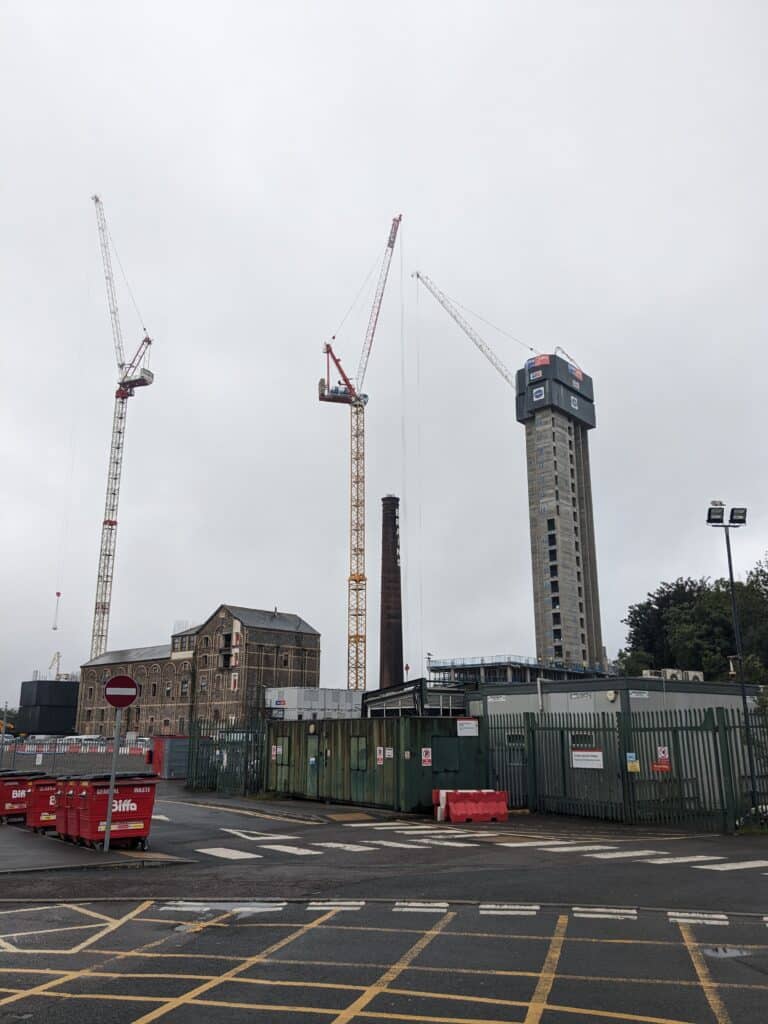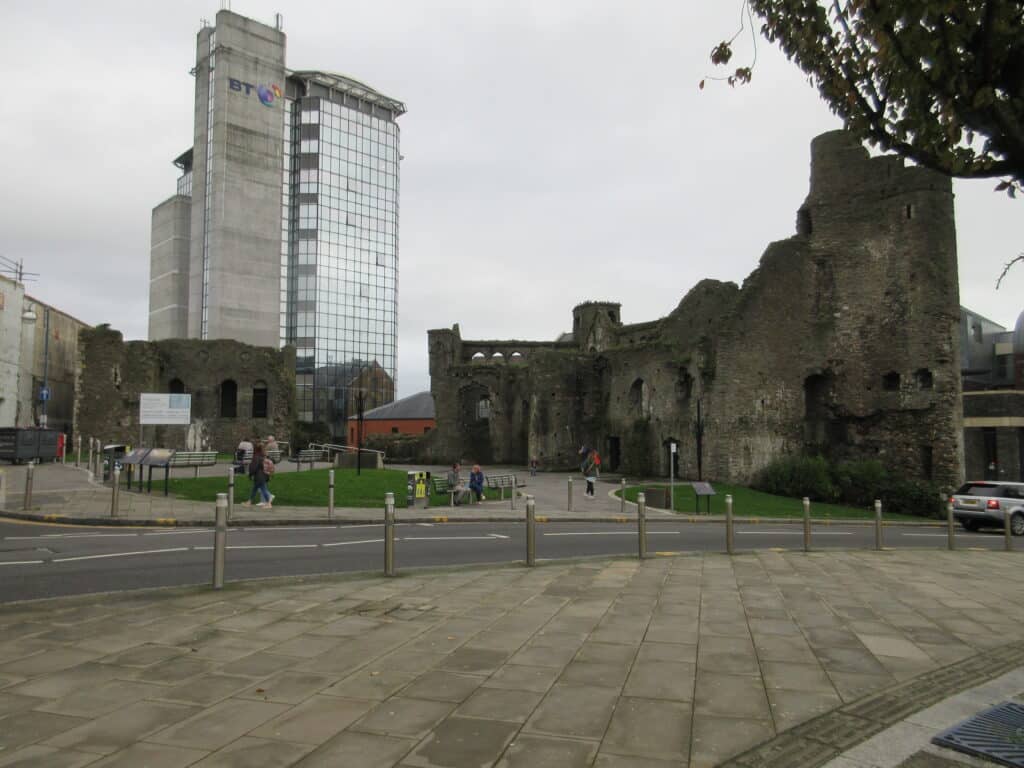Millie Yule
Urban heritage sites are a bit of an oddity. They do not fit into the cast of characters such as castles and country houses no one lives in that you have to pay extortionate prices to get in. Apart from museums and galleries purpose-built in metropolitans to make accessible to the public portable heritage that is often not their own, sites specifically dedicated to heritage more often than not lie beyond the local city bus route. Why is that?
First, from a more pragmatic perspective, urban land is more sought after than rural land. The land is more expensive, so there is going to be greater competition and motivation to rebuild on or develop an existing building. Whether that’s a local factory being turned into luxury apartments,[1] an established community being turfed out to build luxury apartments,[2] or iconic nineteenth century houses becoming the façade of luxury apartments.[3] The Brains Brewery, Tiger Bay, and Guilford Crescent mentioned respectively are all gentrification projects in my hometown of Cardiff but are just a taste of the projects that have and will happen in across Britain. The unifying feature is the complete erasure of any meaningful heritage of the site, but maintaining a single chimney stack with the iconic brand name on to make those moving into the site feel they are really connecting with the city.

Figure 1: The Brains Brewery Development. Photo by the author.
Of course, if the site is empty brownfield, even better! Sites of urban heritage are demolished and just before building starts the project runs out of money because of another financial crash or some other unpredictable event like no one being able to afford to buy luxury apartments. This either means the site is absorbed into a wider building project later down the line, by which time memories of the heritage of the site have started to fade, or the site lies bare in perpetuity. In the latter case, the community does not benefit from the site, being neither a place they can (legally) enter nor the local income it was promised to be by developers. In summary, urban land is sought after and sites of heritage are sacrificed in the machine of progress.
Secondly, from a more heritage-theory-centred aspect, the definition of heritage by the structures that are supposed to protect it are very biased. Much conservation legislation in the UK, such as Graded Buildings and Listed Monuments, were founded in the late nineteenth century. This leaves an echo of Victorian ideology within the legislation, seen in the privileging of physical monumental heritage over the spaces in which intangible cultural heritage is practised. This means that even if a community space, such as a pub, was protected by heritage law it would be due to its architectural values rather than its value as a site that has hosted the community for generations. Even more recently founded institutions still follow the “expert is the authority” line in which someone can only be an expert if they have a formal education and decades of experience in the field. This means that Beverly from down the way isn’t thought of as an expert despite holding the oral history of the community from living memory. Of course, this is slowly changing as more third-sector heritage organisations perform outreach work and community-centred oral history collection. However, this is a change that is only really catching on within the heritage sector itself, and not within the wider world of urban development.
The notion that only certain types of heritage are valuable inevitably favours the protection of certain types of heritage which are then seen as examples of what constitutes urban built heritage. This creates a cycle in which the definition of heritage is unchallenged as it remains reinforced by its own precedent. As stated previously, the definition of heritage that is being reinforced is founded in Victorian values. These values of Empire, Morality, and the Romantic Past mean that communities and histories which do not subscribe to these values are less likely to have their heritage protected, even today. This includes heritage from working class and immigrant communities, as well as those with marginalised identities. Many of these communities lived in the previously undesirable locations within cities, seeking either work or community, and made up the majority of the city’s population. It is these same communities that have been pushed out of these areas by insensitive urban development plans since the 1960s.
Thirdly, it’s no accident that the vast majority of sites cared for by organisations such as the National Trust are rural. As is well known, after the Second World War, many landowners ‘donated’ (or sold) their failing country estates to governmental departments, such as the Ministry of Works, or charitable organisations. This either made the landowners a quick million pounds or enabled them to palm off the inconvenient tumbledown eating into their deep, deep pockets with the helpful bonus of slashing their inheritance tax. These sites reinforce a narrow and exclusionary definition of heritage within the minds of the public. You only need to look at the articles written in certain Conservative papers for a demonstration.[4]

Figure 2: Swansea Castle. Photo by the author.
Even when urban heritage continues to be in existence, it is not given proper treatment. It often lies unused and neglected. During my work placement as part of the Public History and Heritage MA at Swansea University I was placed with Cadw. There, I had the wonderful opportunity of tabulating and mapping the conservation history of Swansea Castle. The actual conservation of the site by the Ministry of Works is a whole other kettle of fish (the process contained more concrete than you would expect), but my work within the placement also highlighted the difficulties in managing urban heritage sites.
Swansea Castle has sat in the centre of the city for hundreds of years. After its time as a medieval castle, it was a newspaper office, a debtors’ prison, a civic centre, and an industrial site. To house all these changing vocations, the physical material of the castle was changed as whole new rooms were built in mismatching red brick and tin, and original walls were knocked through. This meant that by the time the Ministry of Works got their concrete-loving mitts on the place in the 1960s, Swansea Castle was a true Frankenstein’s monster. I personally think this is a very good thing as the continual use of the site beyond its original purpose meant it functioned to serve the city. The mismatching and rather ugly additions were a testament to the site’s long history, only a small proportion of which was spent functioning as a castle. The Ministry of Works didn’t agree with me. Instead, they ‘restored’ the castle to its ‘authentic self’, i.e., they gutted the place of any additions they saw as inauthentic. (Interestingly, they kept the Victorian debtors’ prison in its entirety). Now, Swansea Castle is a ruin in the centre of the city, its position at the top of Swansea’s famous party street the perfect location to make it what one Cadw inspector called a “glorified public urinal”. This is something I’ve had the misfortune of witnessing myself (at 3pm on a Tuesday, no less). It brings into focus interesting questions about how the presentation of heritage sites in urban settings need to be different than the presentation of sites in rural settings; a plant-filled ruin in a field is romantic, a plant-filled ruin sandwiched by a laser tag and a fast-food restaurant is dignified rubble. If the site was treated with care by its care providers, then the public would follow suit. If the Romantic ideals of the treatment of castles have to be abandoned, then so be it. Urban heritage cannot be conceived as a separate part of the urban landscape – it needs to be integrated properly. Ideally, this would be done through the creation of more spaces that actively benefit the community in which the heritage is situated. Instead, as mentioned above, when urban heritage is reused, it is often done through private ownership that bars the public access to their own heritage.
The landscape is a historical palimpsest, and the ability to understand and connect to it can provide an empathy with past peoples and ground modern individual and community identities. The very fabric of a city and its placement on the landscape is a product of countless decisions over centuries. Sensitivity to this is important in modern city regeneration and needs to be considered further than a nominative nod to the area’s history. The brutal gentrification of post-industrial urban landscapes, such as Liverpool Waterfront, are infamous for removing the cultural heritage from the area. The gentrification of Liverpool Waterfront is responsible for UNESCO withdrawing the city from the World Heritage List. I would like to see greater sensitivity towards the history of urban sites as it would allow new buildings to add to the story of the landscape.
Equally, leaving heritage sites empty does little to elevate an area’s sense of self. The use of land is inherently political. Neglecting to use and preventing others from using land makes a strong statement to the lack of regard for the community that that land is within. This is even more true for urban heritage. Cities and towns are built by the communities that live within them, and it is only right that those communities are able to use, and dictate the use of, their own heritage. For this to happen, there needs to be a fundamental shift in the definition of and treatment of heritage within the sector, and a larger emphasis upon community ownership. Of course, this is the antithesis of both traditional heritage ideology and economically ultra-liberal urban development projects. Nevertheless, communities and individuals have always rallied to protect their heritage sites from development, demolition, and neglect, so it is clear that the community energy is there. It is instead the responsibility of the ‘experts’ to engage with and uplift these community efforts to democratise the safeguarding and use of urban heritage.
[1] https://businessnewswales.com/creating-a-new-waterfront-neighbourhood-in-the-heart-of-cardiff-city-centre/
[2] https://www.walesonline.co.uk/news/wales-news/inconvenient-truth-cardiff-bay-history-18402792
[3] https://www.walesonline.co.uk/news/wales-news/saga-guildford-crescent-cardiff-tower-22074028
[4] https://www.spectator.co.uk/article/the-tragic-demise-of-the-national-trust/
